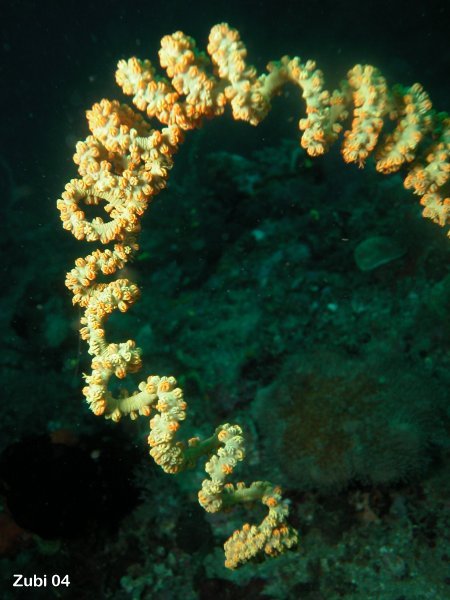Over the past several months LiveAquaria.com has been featuring Spiral Wire (Cirrhipathes spiralis) corals in their Divers Den “New Arrivals” section. As soon as I saw them I was hooked, I had never before seen these colorful uniquely shaped corals for sale or in any saltwater aquarium. I needed one for our tank but first I wanted to read up on it to make sure it was something that we could keep alive. I assumed the Spiral Wire coral was a type of gorgonian which worried me because we haven’t had the best of luck with our previous gorgonians.
A few weeks went by and I kept seeing Spirals pop up on the New Arrivals list but I never got around to researching them. I was way too busy at work trying to make sure all the loose ends were wrapped up before Mercedes had to head out on our cruise to the Western Caribbean.
While on our cruise we made a stop in Roatan, Honduras where we did a little snorkeling. Several of our tour guides made references to “Black Coral” and how we should be extra vigilant while snorkeling not to disturb any of it and not to buy any black coral jewelry in town. I had never heard of black coral before so I wasn’t sure what I was looking for underwater, I just made sure not to touch anything.
Once we got back home to Seattle I had two things on my mind; researching the Spiral Wire coral so I could make one mine and to figure out what exactly black coral was and how it was different then “regular coral”. As it turns out the Spiral Wire coral is a type of black coral.
CoralScience.org has an excellent two part feature on black corals I recommend reading.
http://www.coralscience.org/main/articles/reef-species-4/black-corals-part-one
http://www.coralscience.org/main/articles/reef-species-4/black-corals-part-two
http://www.coralscience.org/main/articles/reef-species-4/black-corals-part-two
Here are some of the highlights from the article and other research I’ve done on black coral.
“The over-exploitation of shallow water black corals for commercial aims, mainly linked to the jewelry trade, led to the inclusion of the entire order in the IUCN list and in Appendix 2 of the CITES list. The most endangered reefs in this respect are those of Hawai'i, Tonga, Ecuador and numerous Caribbean localities. Indonesian reefs are under less pressure caused by the black coral trade.”
“The skeleton of black corals is an organic semi-precious structure known as Antipathin, made of the same chitin which makes up the cuticle of insects,”
"Anchorages of broken fragments are not regenerated, suggesting that fragmentation is not a common reproductive strategy for black corals."
"Laboratory observations conducted on cut tentacles of Indonesian black coral polyps have revealed their high resilience (kept alive in cups for many days) and their ability to reorganize into independent structures."
“Considering the habitat preferences of adults, it has been hypothesized that they tend to settle on inclined substrata, with low light intensity and high nutrient supply.”
“They do not tolerate air exposure caused by tidal movements, which is why they have never been found in the infralittoral zone.”
“In the Hawaiian language, black coral is called ‘ēkaha kū moana and is the official state gem of Hawaii."
“In March 2009, scientists released the results of their research on deep-sea (depths of ~300 to 3,000 m) corals throughout the world. They discovered a subdivision of Black Coral, A. Leiopathes sp. specimens, to be among the oldest continuously living organisms on the planet; around 4,265 years old. They show that the "radial growth rates are as low as 4 to 35 micrometers per year and that individual colony longevities are on the order of thousands of years".
Here are a couple picture I took while snorkeling of what I believe may be black corals.




No comments:
Post a Comment